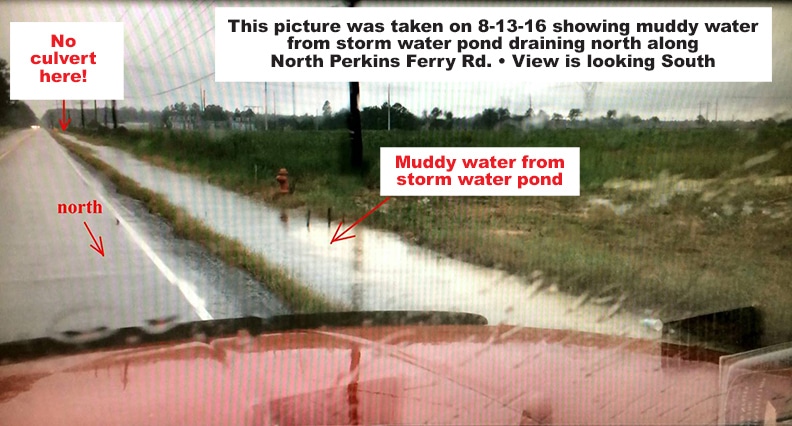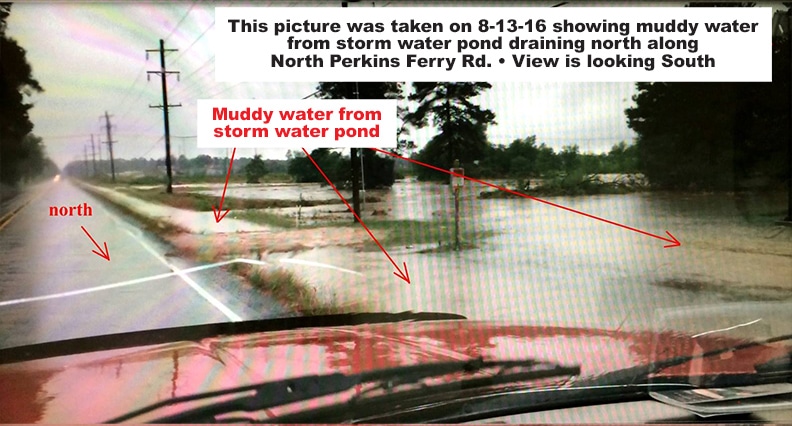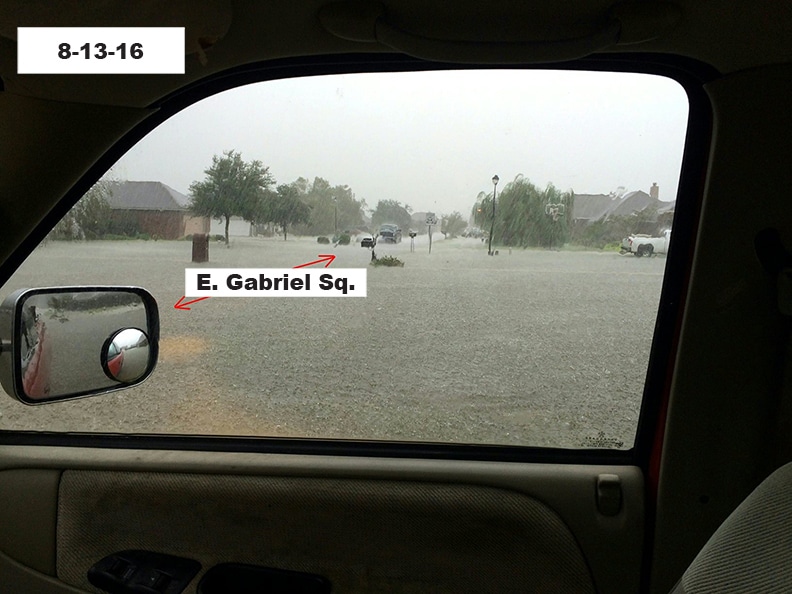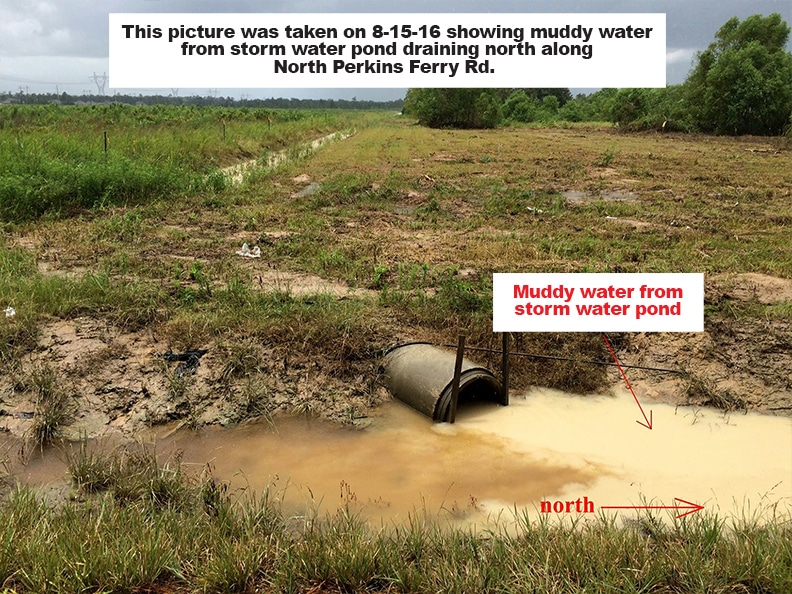SOME WONDER WHETHER A LAKE AREA DETENTION POND IS HELPING OR HURTING THE DRAINAGE SITUATION
STORY BY BRAD GOINS
IMAGES WITH NOTATIONS POSTED BY DAN RHODES ON CITIZENS OF MOSS BLUFF ~ BE INFORMED FACEBOOK PAGE
They have different names: holding ponds, detention ponds, retention ponds. Though the names differ, the stated purpose is always the same. To describe that purpose, I’ll use the easy-to-understand definition from Google:
“A detention pond is a low lying area that is designed to temporarily hold a set amount of water while slowly draining to another location. They are more or less [used] for flood control when large amounts of rain could cause flash flooding. A retention pond is designed to hold a specific amount of water indefinitely.”

Rhodes’ Facebook photos showed “a storm water pond draining its muddy water from west to east into the North Perkins Ferry Road west-side road ditch. This water then drained north and added more water to the streets in Pentangeli Square Subdivision and Coffey Road … “
Rhodes went on to say that “after years of too small culverts in road ditches, no cleaning of ditches, etc., the parish still hasn’t learned how to drain property …”
Finally he asserted that “we don’t want to hold water; we want to drain the water to the bayous, rivers and lakes as fast as feasibly possible.”
The Moss Bluff Flooding group isn’t the only citizens’ group concerned about the affects of retentions ponds in this region. The group Residents Against Flooding in Houston has filed suit in U.S. District Court against Houston and two other entities about flooding from a retention structure. Although the group’s summary of its suit is full of legalese, I think I can edit it to the degree that the suit’s purpose will be clear.
“Plaintiffs bring this case to [stop] … governmental action which … benefit[s] … private commercial interests and developers within Reinvestment Zone Number Seventeen, City of Houston … at the expense of significant harm … to hundreds of residential homes in the nearby Memorial City neighborhoods.
“[Since Reinvestment Zone 17 began in 1999, the City of Houston and the other defendants] … have … implement[ed] drainage and … projects … that … convey storm water out of the TIRZ 17 commercial areas and into the surrounding residential neighborhoods or into their overstrained storm systems.”
The group also claims the defendants have elevated properties in TIRZ 17 in a way that enables flooding in nearby areas and have “postpone[d]” the construction of projects meant to protect surrounding neighborhoods “often in favor of non-essential projects that benefit private commercial interests.”
The suit names one private company in particular — MetroNational Corp. — which it describes as “a private commercial development corporation,” as benefitting from the alleged practices. Indeed, the summary alleges that during the creation of Reinvestment Zone 17, “attorneys working for MetroNational referred to it as ‘MetroNational’s TIRZ.’” If this is true, it could be problematic, as Reinvestment Zone 17 is supposed to be solely a project of the City of Houston.
Other Concerns
In the two groups we’ve looked at in some detail, concerns about detention ponds have revolved largely around the problem of drainage. However, in other locations, some have expressed a variety of concerns about the ponds that are unrelated to drainage.
In a long thread that includes comments from many Real Estate agents, posters assert that people who buy properties next to those that have retention ponds should be aware of two key points. First, the ponds could attract children. Second, the ponds almost certainly will serve as the habitat for some living things, and particularly insects.
These two main concerns generate related concerns. Are the retention ponds fenced in or bordered by walls? Have other measures been taken to try to keep access to the ponds to a minimum?
The question of limiting access also merges with concerns about appearance. Is the retention pond skillfully worked into the landscape on which it sits? If it is not, does it stand out — perhaps in such a way that it constitutes an eyesore?
One real estate agent states that as a general principal, if a potential property buyer finds himself asking “what are the pros and cons of buying a property next to X?” it’s probably best not to buy the property. Many agents in the thread note that potential buyers should be aware that proximity to a retention pond could, depending on circumstances, affect the resale value of a home down the line.
‘It’s Supposed To Be Designed To Work’
Retention, or detention, ponds must work well at least in some places. After all, they’re a structure feature that’s widely used in many parts of the country with no complaints from the citizenry.
One major company that often assists in the construction of retention ponds asserts that problems can arise when such ponds are built by those who don’t have full knowledge about how to build them.
Such a thing should never happen in Calcasieu Parish. Wes Crain, the parish’s head of Planning and Development, says that all retention ponds built in Calcasieu Parish are built according to one set of exacting standards. “Engineers design them in accordance with parish regulations,” says Crain. “All of that has to be engineered. It’s supposed to be designed to work.”
Once plans for retention ponds are completed, says Crain, they are reviewed by the parish’s engineers. “Plans are reviewed to make sure they follow the regulations.”
A Possible Backstory
Crain is more than a little skeptical that complaints about a holding pond at Pentangeli Square are entirely about drainage problems. “I don’t think that’s the bottom line,” he says. “They don’t want the development.” He chuckles a little when he says he thinks some residents are simply “resentful” about housing being constructed on the property in the first place.

Such, says Crain, was never the case. While the owner may at one time have held some interest in putting a public park on the property, he never followed through on the plan. Crain says the Police Jury never approved any plans for a park on the property; nor did it ever forbid the construction of housing on the property.
Mother Nature’s Role
Crain does think it’s possible that even a properly constructed retention pond may overflow at times. “Is there going to be a rain event [that might make it overflow]? I don’t know how you control that. That’s nature.”
When Rhodes wrote on the Facebook page of the Moss Bluff group about the rain event that resulted in the overflowing of the holding pond at Pentangeli Square, he stated that the rainfall on Aug. 12-13 totaled 5-6 inches. In its archives for these dates in Moss Bluff, Weather Underground doesn’t have hourly stats for rainfall. But its hourly stats for Lake Charles Regional for the same period show the following bursts of rain for these two days:
• Aug. 12, 9-10 am: .85 inch
• 11:30 am-noon: 1.5 inches
• Aug. 13, 6:15-8 am: 7.27 inches
• 2-4 pm: 2 inches.
Any way you look at it, it was a major, serious, unusually severe rainfall.
Like hundreds of cities in the U.S., Lake Charles, and much of its metropolitan area, is built on marsh. In marshy terrain, the options for drainage are always, ultimately, limited.
And it is not only coastal location or marshy terrain that creates drainage nightmares. In the United States, flash flooding occurs in areas as diverse as California, Arizona, Illinois and Pennsylvania. Many think that unheard-of weather events — such as the front that was stalled for an inordinately long period over Baton Rouge and created the bizarre flooding there — will only become more frequent as global warming makes its affects felt. (The likelihood of Baton Rouge experiencing 26 inches of rain in less than 48 hours is one tenth of one percent; that probability made the rainfall what the National Weather Service calls a “1,000-year event.”)
The Parish Drainage Plan
On the Moss Bluff group’s page, this notice was posted: “Over the past several months, the Calcasieu Parish Police Jury has been working to develop short- and long-term approaches to help address our parish’s growing drainage problems.
“The Calcasieu Drainage Coalition is a critical component of our plan, given how important it is that any drainage-related policies or ordinances that are put in place be aligned at both the parish and municipal levels …”
The Police Jury completed work on its parish drainage initiative in mid-October.
The plan recommended that the Calcasieu Drainage Coalition work “with cities and drainage districts to develop complementary polices throughout the parish, develop related development ordinances and determine the next steps on capital projects and related funding.
The plan stipulated that both current and long-term needs must be addressed through both policies and projects.
All approaches must be based on two key components: public feedback and “sound science and engineering.”
Approaches to maintenance of projects must be realistic.
The Police Jury will take the lead in acquiring capital funding for drainage projects. Cities and drainage districts should keep the Police Jury informed about what projects they feel should be funded.
As of now, funding will exist in the form of a three-year program that will be updated annually. Part of the funding effort will involve ensuring that sufficient funding goes to “smaller areas.”
The Calcasieu Drainage Coalition is meant to serve as the “glue” of the drainage program. The Coalition must “serve a key role in the consistent enforcement of policies and ordinances for development and maintenance.”
Members of the coalition will include such people as public works directors, planners, engineers, parish and city staff and representatives of the DOTD.
The group will start its work with short-term meetings that will gradually evolve into quarterly meetings. Meetings will also be held after major rain events and other disasters and emergencies.
The initial list of the Top 10 projects of the Coalition should be released in Spring of next year.
A few specific regulations were altered. For example, the prohibition on development within the first 200 feet of a flood plain area was removed.
These plans came about as the result of three public open houses about drainage; two public comment periods; and 138 comments by citizens about drainage issues. Mayors, members of city councils and members of drainage districts were part of the deliberation process.
In an American Press story on the adoption of these drainage measures, it was stated that the provisions will be designed to be applied to unincorporated areas as well as others.
Contact Information
If you have a concern with a drainage situation, contact the person in charge of the entity that’s creating the situation. If you’re concerned about drainage of ditches or streets in your neighborhood, talk with your neighbors. In particular, if you make any drainage changes to your property, let your immediate neighbors know. To the degree you are able, coordinate drainage efforts with your neighbors.
Of course, you can keep any drainage grates near your property open for water intake simply by raking any leaves, branches or other blockage out of the grates.
If the efforts of you and your friends aren’t doing the job, you may find this contact information useful:
— Allen Wainwright (who is affiliated with the Calcasieu Drainage Coalition): 721-3700.
— Police Jury Engineering and Public Works: 721-4100.
— Flooding and culverts departments: 721-3600.
— Ditch maintenance: 721-3700.
— If none of these numbers are working for you, call the Policy Jury’s administrator’s office at 721-3510.
— The Gravity Drainage District 8 (applicable to residents in Ward 1) can be reached at 855-4388.
To see the comments of the residents in the Moss Bluff group or to follow the group, go to Facebook and search for “Moss Bluff Flooding Surrounding Areas.”
















Comments are closed.